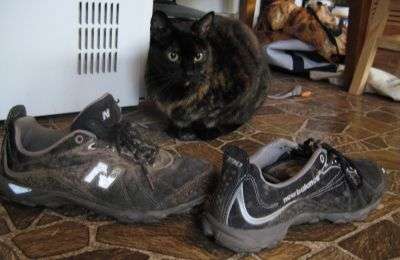trail run #2
 Yesterday was my second trail run: the EnviroSports Huddart Park "half-marathon". It was my first EnviroSports event. I'd thought Pacific Coast Trail Runs, the promoter of my first run (also at Huddart, in December) was low-key.... When Dave of EnviroSports announced that if we took time to admire the view, we should record how long we did so and it would be deducted from our official time, I was impressed! And earlier, when I'd asked how we check-in at the turn-around, I was told it was "sort of on the honor system". This trail running thing is cool.
Yesterday was my second trail run: the EnviroSports Huddart Park "half-marathon". It was my first EnviroSports event. I'd thought Pacific Coast Trail Runs, the promoter of my first run (also at Huddart, in December) was low-key.... When Dave of EnviroSports announced that if we took time to admire the view, we should record how long we did so and it would be deducted from our official time, I was impressed! And earlier, when I'd asked how we check-in at the turn-around, I was told it was "sort of on the honor system". This trail running thing is cool.The profile was simple: up for 6 miles, down for 6 miles. Not quite a "half-marathon", after all, according to the official course profile.
 |
I had new shoes for this one: New Balance 790 lightweight neutral strike trail shoes. I love these shoes, and was lucky to grab them, as they've been discontinued: apparently lightweight trail runners are not in demand. Chi Running advocates lightweight shoes, relatively loose to not constrict the foot: typically a half to full size larger than otherwise, laced such that the shoe can be removed without unlacing. I've followed these guidelines, and my feet have been happy throughout my return to running this winter season. These shoes are 136 grams heavier than my Nikes, but if the improved tread saves only 5 mm of slippage per meter of uphill stride, that's 30 seconds saved per 50 minutes of climbing. If uphill speed is inversely proportional to total mass, that's 22 seconds saved after accounting for the weight difference. Add in an intangible increase in confidence on the descents, especially in yesterday's muddy conditions, and I strongly suspect they're the better choice.
My other new toy: a Nathan water bottle belt. There's two issues here:
- Carry or not?
- Belt or hand?
So it comes down to the question: did regular hydration improve my climbing speed by at least 15 seconds? A nontrivial question, as so much depends on conditions. I was under 55 minutes to the turnaround, so the question is how does one compare the benefits of a hastily gulped drink 55 minutes into an effort to sips every approximately 7 minutes?
I don't know. For longer events, or in hotter weather though, portable hydration gets the nod. And once I had the elastic straps tight enough, this belt worked great. I was able to retrieve and replace my bottle in a full run without issue.
Okay, so the other issue is hand versus belt. Trail runners often carry bottles in their hand. To me, this is nuts. First, it imbalances the arm swing, which imbalances the stride. Second, it fatigues the arm holding the bottle. Sure, you can swap it from arm to arm to distribute the load, but still... Perhaps this is some sort of "old school" thing. Another factor is weight. Belts are heavier. But hand carrying just seems the wrong way to go.
Oh, yeah.... the run. Well, a brief summary. Approaching the turn-around, I stepped in some mud and immediately heard a "suck!-pop!" only to find myself continuing on in one shoe. I swung around and somehow managed to snag both of my light-weight gloves on the barbed wire fence bordering the trail. The amazing thing is my hands never touched the stuff: not a scratch. I managed to reattach my shoe and get my gloves off the barbs without much of a problem: I lost one place, from 14th to 15th. This almost reoccurred during my return, but by curling my toes I was able to keep my shoes from detaching.
On the descent, a repeat of my frustration from December. I just can't descend as fast as my competitors: I lost 7 places from the turn-around (15th) to the finish (22nd), crossing the "line" (actually "reaching the finishing table") in 1:34:58. I'd thought then it was flexibility and stride length. But I've been working ever since on my hip flexibility. Now I think differently: simply muscular adaptation. The only time I ever run on trails is during these races. I simply think the muscles stressed during down-trail running aren't up to the task, limiting how fast I'm willing to go. So the simplest answer: practice.
What's next? I don't know at this point. I should refocus on riding. But come fall, I'm ready to start again with running. Maybe the Sacramento Marathon in December. It's a Boston qualifier, and I should have more than enough time to prepare for it after the end of the cycling road season in September.
Oh, yeah -- and more trail runs! They're a blast.
added: Here's someone's GPS data from the race. GPS-derived distance is unreliable due to signal-drops on the highly circuitous route: the GPS interpolates straight lines between locations.

Comments